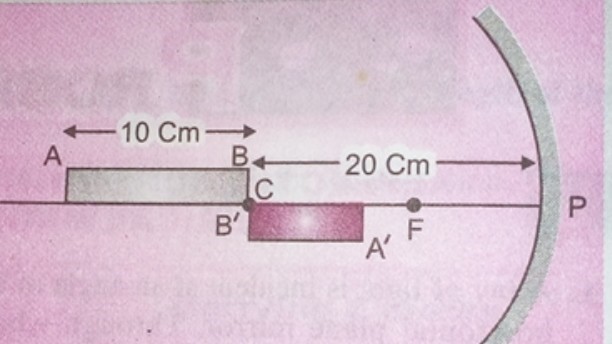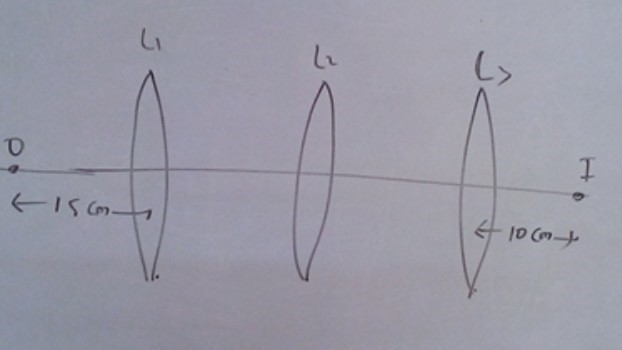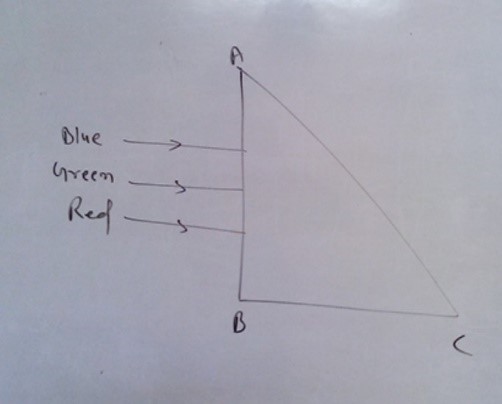Important numerical of ray optics
All questions given below is very important numerical of ray optics . These questions are good for quick practice at the time of examination.
- Suppose while sitting on a parked car , you noticed a jogger approaching towards you in the rear view mirror of R=2m . If the jogger is running towards you at the speed of 5m/s , how fast the image of the jogger moving when the jogger is (a)39m(b)29m(c)19m away.
2. A rod AB =10cm in length is placed along the principle axis of a concave mirror having focal length equal to 10cm as shown in fig. the distance PB=20cm . what is the length of the image of the rod AB.

- When an object is placed at a distance of 60 cm from a convex spherical mirror , the magnification produced is ½. Where should we place the object to get a magnification of 1/3?
- A ray of light travelling in water is incident on water glass interface at angle 300calculate the angle of refraction. Refractive index of water and glass is 4/3 and 3/2 respectively .
- What is apparent position of the object below a rectangular block of glass 6cm thick , if a layer of water 4cm thick is on the top of the glass ? Refractive index of glass and water with respect to air is 3/2 and 4/3 respectively.
- Calculate the critical angle for total internal reflection of light travelling from (a) water to air(b) glass into water. Refractive index for glass and water is 3/2 and 4/3 respectively with respect to air.
- Light from a point source in air falls on a spherical glass surface .If refractive index of glass is 1.5 and radius of curvature =20cm , the distance of light source from the glass surface is 100cm ; at what position image will formed?
- A biconvex lens has a focal length 2/3 times the radius of curvature of either surface . Calculate the refractive index of lens material .
- Find the radius of curvature of the convex surface of a plano-convex lens , whose focal length is 0.3m and the refractive index of the material of the lens is 1.5.
- A screen is placed 100cm from an object . The image of the object on the screen is formed by a convex lens at two different locations , separated by distance 20cm . calculate the focal length of the lens used.
- You are given three lenses L1 , L2,L3 each of focal length 10cm . an object is kept at 15cm in front of L1 , as shown in fig. the final image is formed at the focus of L3 find the separation between the lenses.

- A convex lens made up of glass of refractive index 1.5 is dipped , in turn ,in (a) a medium of refractive index 1.65 (b) ) a medium of refractive index 1.33.Will it behave like converging or diverging lens in two cases, explain how focal length changes in two cases .
- Three rays red , green and blue are incident on a right angled prism ABC at face AB the refractive indices of the material of the prism for red, green ,and blue are 1.39,1.44, and 1.47 respectively . Out of the three which color of ray emerge out of face AC. Trace the path of the three rays after passing through AB.

- Draw ray diagram to show how specially designed prism make use of total internal reflection to obtain inverted image of the object by deviation of rays (a) through 900 (b) through 1800 and(c) through 00 .
- State the conditions under which total internal reflection occurs . one face of a prism with a refracting angle of 30 , is coated with silver . A ray incident on another face at an angle of 45 is refracted and reflected from the silver coated face and retrace its path. Find the refractive index of the material of the prism.
- A convex lens with the radii of curvature of magnitude 10 cm each , is put over a liquid layer is poured on the top of the plane mirror . A small needle with its tip on the principle axis of the lens , is moved along the axis until its inverted real image coincide with the needle itself . The distance of the needle from the lens is measured to be 15 cm . on removing the liquid layer and repeating the experiment the new distance is measured to be 30cm ,what is the refractive index of the liquid?
- Find the position of the image formed by the lens combination given in figure

- A diverging lens of focal length f cut into two identical parts ,each forming a plano- convex lens what is the focal length of each part. How the focal length of the lens changes if it bisected axially?
- The image of a needle placed 45cm from a lens is formed on a screen placed 90 cm on the other side of lens. Find displacement of image if object is moved 5cm away from lens.
- A small bulb is placed at the bottom of a tank containing water to a depth of 80 cm . what is the area of the surface of water through which light of the bulb can emerge out ?Refractive index of water is 1.33 consider the bulb to be a point source.
Service Unavailable
The server is temporarily unable to service your request due to maintenance downtime or capacity problems. Please try again later.
Additionally, a 503 Service Unavailable error was encountered while trying to use an ErrorDocument to handle the request.